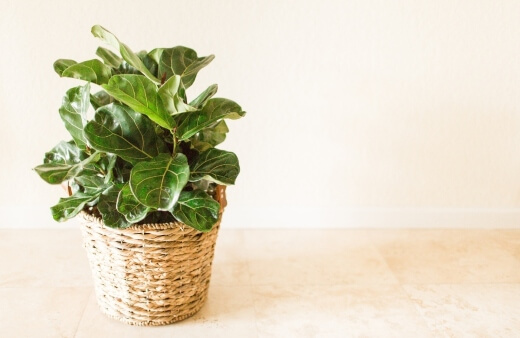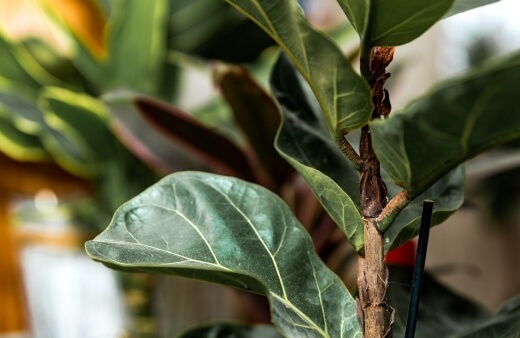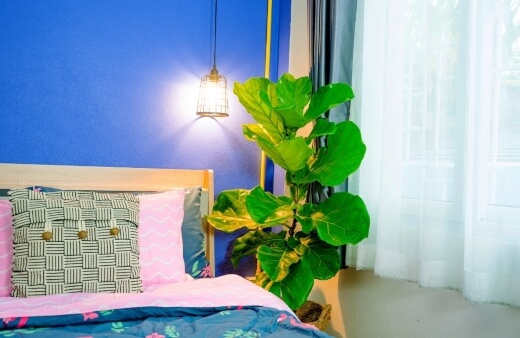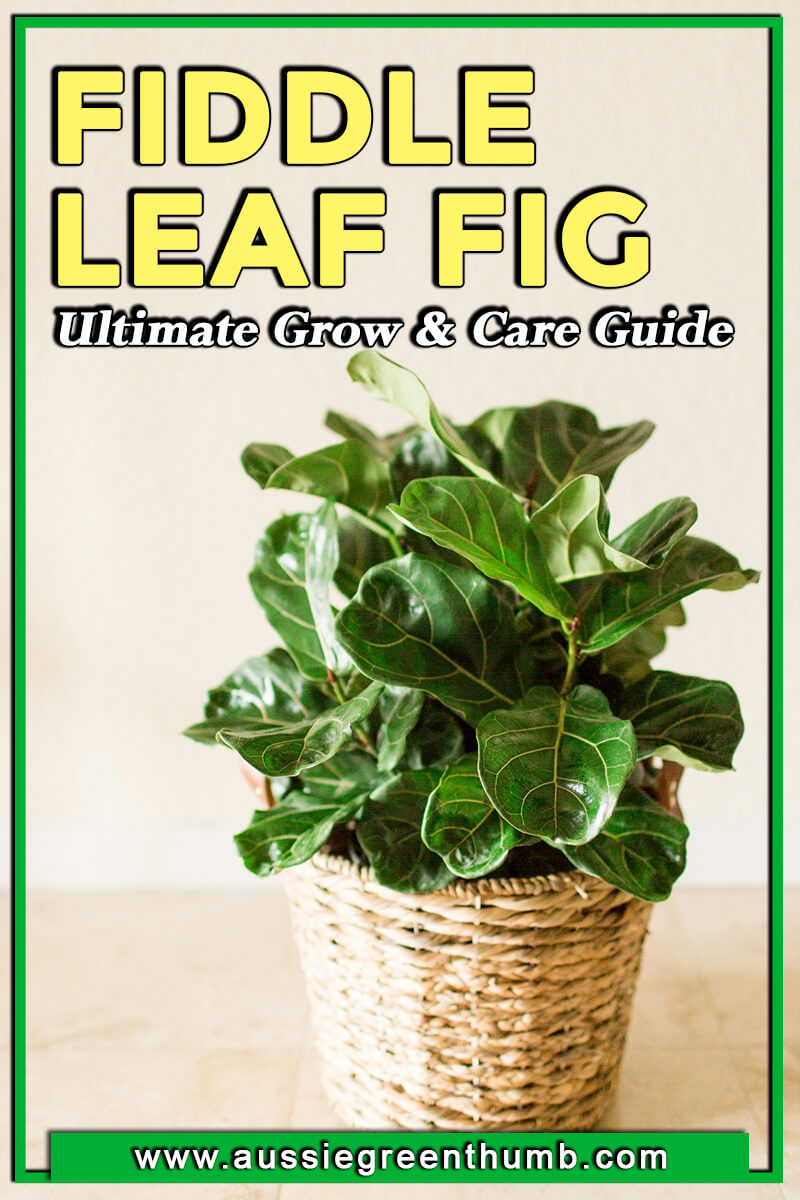Indoor plants are a great way to bring nature indoors and add some striking focal points to your apartment or home. Tropical plants are always a great option as they are naturally accustomed to warm conditions with indirect light.
The fiddle leaf fig is a popular indoor plant, ideal for indoor growth. This broadleaf evergreen is tall-growing, striking and relatively easy to get situated.
Here is what you’ll need to know to cultivate, care for and grow fiddle leaf fig.
More...
Family: | Moraceae |
|---|---|
Genus: | Ficus |
Species: | F. lyrata |
Common Names: | Fiddle-leaf fig, banjo fig |
Location: | Indoor |
Type: | Broadleaf evergreen plant |
Growth: | 1.2 to 2 metres tall, 1 metre wide (indoors) |
Sun requirements: | Partial shade |
Foliage Colour: | Green |
Flower Colour: | Insignificant |
Flowering: | Rarely flowers in cultivation |
Maintenance level: | Medium |
Poisonous for pets: | Toxic to cats and dogs |
Introducing the Fiddle Leaf Fig

Although this species is now being found across the globe, the fiddle leaf fig is native to the tropical regions of West Africa. Belonging to the Moraceae family, the Ficus lyrata or fiddle leaf fig is a fast-growing plant with large, glossy, violin-shaped leaves and sleek, slender trunk.
Also known as the Banjo Fig, this evergreen plant has become increasingly popular over recent years due to its growth habits. This cultivar can be planted at any time of the year, and with a little bit of extra attention, will turn into a bushy, luscious large-leaved plant.
In its natural habitat, this cultivar can grow as much as 12 to 15 metres tall. However, when grown indoors, it usually stays around 1.2 to 2 metres tall.
This plant is toxic to cats and dogs so be sure to position your plant accordingly.
How to Grow Fiddle Leaf Fig Tree

Due to its tropical origins, the Ficus lyrata thrives in warm and humid conditions, which can often be challenging for beginner growers to get right. Still, this species is relatively tough and resilient and will allow you some time to get the conditions right.
Ideally, you’ll need to grow your fiddle leaf fig in a warm, sheltered position that receives bright, unfiltered light. It is important to note that too much direct sunlight may scorch the leaves.
Try to avoid the hot afternoon sun altogether, if possible. More so, if the light conditions are too low, your fiddle leaf fig may experience stunted growth.
An east or north-facing window should provide you with the right level of light. When it comes to soil, you can choose any rich potting mix which is formulated for indoor plants.
It is possible to find specialised soil mixes designed for the fiddle leaf fig tree. However, it is not necessary. Try choosing a rich, well-draining loam-based soil mixture.
This species is also accustomed to particularly hot and humid conditions; as such, it doesn’t enjoy any major temperature fluctuations. Avoid keeping your fiddle leaf fig tree near heaters or air-conditioners or in a direct draft.
Unless you’re keeping your fiddle leaf fig in the bathroom or kitchen, where humidity tends to be higher, you can also support your plant with some extra moisture by regular misting or placing it onto a pebble tray.


Get Your Free Guide:
Master Growing Australian Natives eBook
A Must Have Complete Guide for Every Australian Garden
Get Your Free Guide:
Master Growing Australian Natives eBook
A Must Have Complete Guide for Every Australian Garden
Propagating Fiddle Leaf Fig

Unfortunately, propagating fiddle leaf figs from seed is incredibly difficult, which is why many growers simply opt to buy an existing plant from their local garden centre.
However, it is also possible to propagate fiddle leaf fig from a cutting, and luckily, it’s fairly fool-proof. Here is what you’ll need to do:
- Using a sterilised, sharp pair of shears, remove a stem cutting about 30 to 45 cm in length. (Here's our review of the best garden secateurs)
- Carefully pinch back all other leaves except for one. Try choosing the healthiest looking leaf to keep.
- Place the end of the stem into a jar of fresh, clean water.
- Keep your cutting in a warm, draft-less position, ensuring it receives a good amount of indirect sunlight every day.
- As soon as the water begins to look murky, change it out. This should be every few days.
- After a few weeks, you will begin to notice little bumps at the base of the cutting. Soon these bumps will form into roots.
- Once these roots are about 5 cm long, you can remove the cutting from the water and plant into a rich soil mixture.
Potting Ficus lyrata

Once your cutting has begun to produce a significant amount of new growth, it may be time to consider re-planting your fiddle leaf. For young plants, it is recommended to try and re-pot them once a year during the spring.
Simply:
- Choose a pot whose diameter is about 10 cm larger than the previous pot.
- Gently remove your fiddle leaf fig from its original pot, supporting the base.
- Place it into the new pot. Then, fill the spaces around it with a fresh potting mix.
This can be done annually for the first few years of growth. Thereafter, your fiddle leaf fig tree will likely be too big to re-pot. In this case, you can merely remove the first 10 cm of soil at the top and replace it with a layer of fresh soil.
Fiddle Leaf Fig Care Guide

Unfortunately, while the fiddle leaf offers spectacular foliage year-round, it will also require a bit of your attention throughout the year.
One of the most common fiddle leaf fig care tips available is that it’s essential to regularly shake and rotate your fiddle leaf.
Shaking your fiddle leaf helps to mimic a natural wind, which stimulates strong root and foliage growth. Regularly rotating your tree will ensure that each leaf gets sufficient light, meaning you won’t have any uneven growth.
It is also recommended to regularly dust your leaves with a damp cloth to remove any residue from them. This will allow the leaves to photosynthesize better.
The fiddle leaf fig tree enjoys a moderate level of soil moisture, so you’ll want to make sure you’re watering it at least once a week. Be sure to check on the soil regularly to ensure that the soil is neither too dry nor too wet.
In Winter, you will only need to water once every two weeks or so. This species is particularly sensitive to salt levels in the soil. As such, it’s a good idea to flush the soil annually, especially when living in coastal regions.
A high-nitrogen fertiliser can be added during spring and summer to help support big and bushy growth. Avoid fertilising in Winter altogether.
Semi-regular pruning should also be done to remove any dead or damaged leaves and to avoid over-growth and crossing leaves. Pruning will help to create room for growth and allow the leaves to breathe.
Trimming off the top can also be done during the Winter to help promote wider bushy growth in the summer.
Are you looking for other indoor plants to turn your home or apartment into an oasis? Take a look at our favourite indoor plant options.
Ficus lyrata Common Problems, Pests & Diseases
This plant can be very sensitive to its environment, so if you’re not following the right fiddle leaf fig care, you may run into some issues. As they are mostly grown indoors, the fiddle leaf doesn’t have many pests or disease issues.
You may need to keep an eye out for spider mites or scales. These are noticeable when leaves become damaged or start to develop dark spots. Consider using a natural insecticide before heading for a stronger, chemical option.
If your plant begins dropping its leaves, this is a clear sign that something in its growing environment is wrong and the plant is in shock. This could be many things such as that the plant is too cold, too dry, too wet or the light levels are too low.
You’ll have to take your time to properly access which factor is causing the leaves to drop and adjust accordingly. Some eco-seaweed can help reduce stress in your fiddle leaf.
Fiddle Leaf Fig Frequently Asked Questions
Why are my fiddle leaf fig leaves wilting?
Wilted or scorched leaves can be a sign that your fiddle leaf fig is receiving too much sunlight and too little water. Consider relocating your plant and regularly checking the soil to ensure it is moist. You can also increase how often you mist your fiddle leaf.
Why are my fiddle leaf fig leaves drooping & dropping?
Sudden leaf drop, drooping and brown spots are all a sign of overwatering. The best way to treat this issue is to re-pot your fiddle leaf in some fresh soil.
Before planting, gently cut back any mushy roots and remove browned leaves.
Why are my fiddle leaf fig leaves turning yellow?
Yellowing leaves are an indication that you may have a bacterial problem. Unfortunately, these issues are generally quite hard to treat—attempt re-planting your fiddle leaf and removing yellowed leaves.
Interested to discovering other Ficus species to grow in your garden? Check out our in-depth guide to growing Ficus pumila, commonly known as Creeping fig.

Wrapping Up Our Fiddle Leaf Fig Guide
So, there you have everything you need to know to grow the fiddle leaf fig tree. Be sure to follow these fiddle leaf fig care instructions to ensure that your fiddle leaf has everything it needs for big and bushy growth.
Published on July 28, 2022 by Maisie Blevins
Last Updated on February 22, 2024





Hello,
You mentioned trimming in winter, how much can I trim. My fiddle is becoming lopped sided and at also 3 metres tall I need to bring it back down to size.
Help
Hi Nicole,
By the sounds of things, you seem to have a healthy and thriving fiddle leaf, so, congratulations there. It is a common complaint that these plants do tend to grow very tall in good conditions, often accompanied by lopsided or leggy growth.
Let’s start with cutting your plant down to size. Pick branches to cut back that will offer a more symmetrical shape once cut and also help decrease crowded areas. Locate a good spot between the nodes and leaves on the branch. Cut just below a leaf using sharp and sterilised pruning shears, you may also need a rag for excess sap.
You can cut away the branches quite aggressively to reduce the size and pot larger cuttings to start growing new plants if you desire. Just remove some of the lower leaves on the cuttings beforehand.
I would suggest only making three to four cuts at any given time to prevent any shock then allow your plant to recover before cutting again. Be sure to water and fertilise your plant after the procedure and give it good lighting to assist with recovery.
To keep the plant growing symmetrically and to prevent lopsided growth, be sure to regularly rotate your fiddle leaf. The plant may require improved lighting conditions as well, just no direct sunlight. If the leaning is more severe, you could always consider installing a stake to support the main branch.
Other than that, just return to your usual care routine and the plant should recover and develop new growth in the coming season.
I hope this information helps you successfully cut your fiddle leaf down and improve its shape and growth habit.
Happy gardening from team AGT!
Hello I'm after some advise with this Fiddle Leaf Tree. It is getting so tall and leaning now. What if anything can I do to it? I rotate it and it usually straightens up but it's so tall now it's not. Is there a way to trim it? also some of the leaves are brown on the tips can I pull them off will new ones grown back?
Hi Kerry,
I know the pain of this all too well. We had a fiddle leaf fig that was doing exactly the same – caused by mealy bug, which were eating up every last bit of goodness in the soil and causing the roots to overwork.
First thing you’ll need to do, if it’s got anything to do with mealybug is remove the brown leaves, and replace the soil (the goodness will be spent). It’s easy enough, just tip the plant out of its pot and carefully shake off what soil you can, leaving the root ball intact.
If you pull the leaves off, they can grow back from lower down nodes, but what I found worked (and gave me a much nicer plant) was to cut it down to above a lower node (about 20cm up from the soil).
After weeks later, new sprouts came out and now (two years on) I’ve got a fiddle leaf fig with two stems, which is bushier and happier than ever.
I hope that helps!
Maisie Blevins